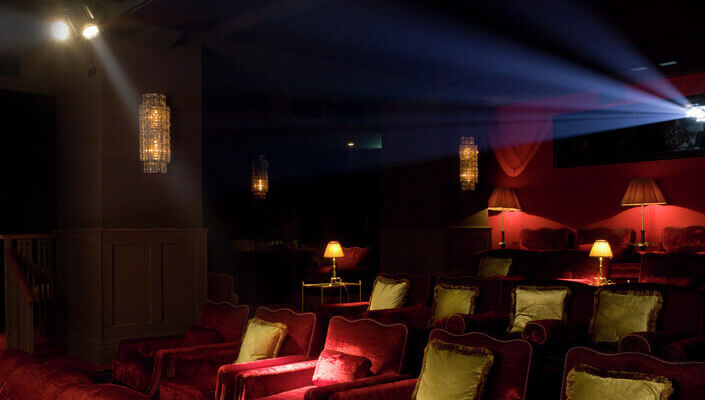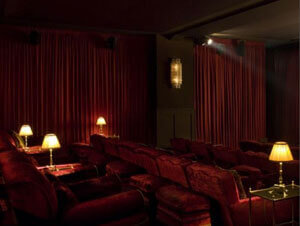Home cinema design considerations


When planning a home cinema, the size of the space you’re using dictates everything from the size and type of screen, to the type of projector you choose.
Screens
There are several types of screen suitable for the home cinema but the best choice would be a static 16x9” screen, which resembles a wide screen TV.
If the room will be used for other purposes, a screen that glides down from the ceiling would be a good option.
But if you, or your client, is a cinema enthusiast, and you’re looking for a truer cinema experience, there are several types of screen from which to choose.
There are different options too for the screen surface: your choice will be dictated by the space and by what you want to achieve. Take a look at our Knowledge Base article K5 ‘Choice and application of different projection screen surfaces’ for more information on screens and surface choices.
Matt white is used as standard in smaller, studio-style professional theatres where the side walls are in line with the sides of the picture, and it’s a good option for home cinemas.
The ideal position for speakers is at the back of the screen, and some screens have perforations, which allow the sound to come through.
There are different types of perforation: standard, micro and mini and there are compromises with each type.
Standard perforations give better sound but if the audience is too near the screen they will see the holes. So, once again the size of the room is the important factor, as it will dictate the number of seats you can have and their proximity to the screen.
Mini perforations are better for viewing a film close up, but the sound quality very slightly reduced. However, now that most film soundtracks are digital, this type of surface is probably a good choice as the image quality is better and the sound quality is only slightly reduced.
Positioning projectors
As with screens, several types of projector are suitable for a home cinema.
Once you’ve chosen your projector, you need to think about where to position it. Ideally, it needs to be as low as you can get away with and as square on to the screen as possible to eliminate keystoning.
The keystone effect distorts the dimensions of an image, making it appear as a trapezoid. It’s caused when an image is projected onto a surface at an angle. Some areas of the screen may not be focused correctly as the projector lens is focused at the average distance only.
Projector noise is another consideration. Some are noisier than others and you may want to consider putting your projector in a housing insulated with Camtek acoustic foam.
Placing speakers
The true cinema experience is all about the sound and the best place to position the main speakers is behind the screen. That means there needs to be space for the screen to move forwards to accommodate them.
It’s recommended that the left, right, and centre speaker channels should be situated at a height of two-thirds in the auditorium. That’s because the actors heads are usually at that height on the screen, so that’s where the speech will come from.
They should also point at a spot two-thirds along auditorium away from the screen to the centre seat. This replicates the premium seats in a professional cinema. Furthermore, the surround sound speaker should be two-thirds up from the floor and pointing to the same place.
If it’s not possible to situate the speakers behind the screen the next best place is just underneath or they can be above. But the channels still need to be in the right place to focus the sound as this is what focuses the viewer on the correct place on the screen.
Of course the acoustics need to be correct in the room for any of this to happen properly.
Acoustics
Acoustic walls stop reverberation and control sound to ensure it comes from the correct place.
It’s a good idea to carpet the floor because you need to remove as many hard surfaces as you can to control reverberation.
Good quality cloth walls, and having the speakers in the right places, will help to improve sound quality, but if you want to achieve the purest sound possible in your space, you need think about acoustic wall treatments
Acoustic wall treatments
Everything in a space, from the walls and windows to the floors and ceilings, has an effect on how sound behaves. And of course the size and shape of a room plays a huge part too.
Acoustic treatments address the sound quality of a room by absorbing high levels of reflective noise. So a film’s soundtrack will be much more accurate in a professionally treated auditorium than in one that’s untreated.
The design is marked out directly on to the walls. The plastic is cut to the design and each individual piece is fitted to wall to create panels or a continuous stretch. These are then in-filled with foam. The final step is to cover the foam with cloth, fitting it into the frames.
Camtek forms the core of Camstage acoustic panels. Our own product, Camtek is a flexible, lightweight melamine-based acoustic foam with a Class 0 fire specification. It comes in sheets with a standard depth of 32mm, which provide a high sound absorbency.
Any stretch fabric can be used so there is a very wide range of colour and designs from which to choose. This makes the panels extremely flexible as they can be tailored to individual specifications and design themes.
However, most modern professional cinemas are now opting for black fabric to take as much light out of the room as possible to give a better picture on the screen.
You need as much light bouncing off the screen as possible for the best effect. The screen absorbs ambient light from any source, so too much and you start to lose detail, particularly with 3D.
Please see our article KB1 ‘Acoustic wall qualities and criteria for professional cinemas’ for more information.



